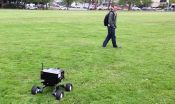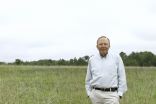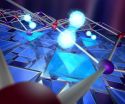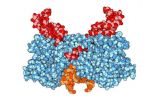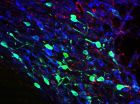(Press-News.org) It's not uncommon to see cameras mounted on store ceilings, propped up in public places or placed inside subways, buses and even on the dashboards of cars.
Cameras record our world down to the second. This can be a powerful surveillance tool on the roads and in buildings, but it's surprisingly hard to sift through vast amounts of visual data to find pertinent information - namely, making a split-second identification and understanding a person's actions and behaviors as recorded sequentially by cameras in a variety of locations.
Now, University of Washington electrical engineers have developed a way to automatically track people across moving and still cameras by using an algorithm that trains the networked cameras to learn one another's differences. The cameras first identify a person in a video frame, then follow that same person across multiple camera views.
"Tracking humans automatically across cameras in a three-dimensional space is new," said lead researcher Jenq-Neng Hwang, a UW professor of electrical engineering. "As the cameras talk to each other, we are able to describe the real world in a more dynamic sense."
Hwang and his research team presented their results last month in Qingdao, China, at the Intelligent Transportation Systems Conference sponsored by the Institute of Electrical and Electronics Engineers, or IEEE.
Imagine a typical GPS display that maps the streets, buildings and signs in a neighborhood as your car moves forward, then add humans to the picture. With the new technology, a car with a mounted camera could take video of the scene, then identify and track humans and overlay them into the virtual 3-D map on your GPS screen. The UW researchers are developing this to work in real time, which could help pick out people crossing in busy intersections, or track a specific person who is dodging the police.
"Our idea is to enable the dynamic visualization of the realistic situation of humans walking on the road and sidewalks, so eventually people can see the animated version of the real-time dynamics of city streets on a platform like Google Earth," Hwang said.
Hwang's research team in the past decade has developed a way for video cameras - from the most basic models to high-end devices - to talk to each other as they record different places in a common location. The problem with tracking a human across cameras of non-overlapping fields of view is that a person's appearance can vary dramatically in each video because of different perspectives, angles and color hues produced by different cameras.
The researchers overcame this by building a link between the cameras. Cameras first record for a couple of minutes to gather training data, systematically calculating the differences in color, texture and angle between a pair of cameras for a number of people who walk into the frames in a fully unsupervised manner without human intervention.
After this calibration period, an algorithm automatically applies those differences between cameras and can pick out the same people across multiple frames, effectively tracking them without needing to see their faces.
The research team has tested the ability of static and moving cameras to detect and track pedestrians on the UW campus in multiple scenarios. In one experiment, graduate students mounted cameras in their cars to gather data, then applied the algorithms to successfully pick out humans and follow them in a three-dimensional space.
They also installed the tracking system on cameras placed inside a robot and a flying drone, allowing the robot and drone to follow a person, even when the instruments came across obstacles that blocked the person from view.
The linking technology can be used anywhere, as long as the cameras can talk over a wireless network and upload data to the cloud.
This detailed visual record could be useful for security and surveillance, monitoring for unusual behavior or tracking a moving suspect. But it also tells store owners and business proprietors useful information and statistics about consumers' moving patterns. A store owner could, for example, use a tracking system to watch a shopper's movements in the store, taking note of her interests. Then, a coupon or deal for a particular product could be displayed on a nearby screen or pushed to the shopper's phone - in an instant.
Leveraging the visual data produced by our physical actions and movements might, in fact, become the next way in which we receive marketing, advertisements and even helpful tools for our everyday lives.
Inevitably, people will have privacy concerns, Hwang said, and the information extracted from cameras could be encrypted before it's sent to the cloud.
"Cameras and recording won't go away. We might as well take advantage of that fact and extract more useful information for the benefit of the community," he added.
INFORMATION:
Co-authors are Kuan-Hui Lee, a UW doctoral student in electrical engineering, and Greg Okopal and James Pitton, engineers at the UW Applied Physics Laboratory.
The research was funded by the Electronics and Telecommunications Research Institute of Korea and the Applied Physics Laboratory.
For more information, contact Hwang at hwang@uw.edu or 206-685-1603.
Project website and related paper: http://allison.ee.washington.edu/kuanhuilee/mcpt/
Video: http://youtu.be/gt4XieUwWP8
ITHACA, N.Y. - Peering deep into time with one of the world's newest, most sophisticated telescopes, astronomers have found a galaxy - AzTEC-3 - that gives birth annually to 500 times the number of suns as the Milky Way galaxy, according to a new Cornell University-led study published Nov. 10 in the Astrophysical Journal.
Lead author Dominik Riechers, Cornell assistant professor of astronomy, and an international team of researchers gazed back - with the Atacama Large Millimeter/submillimeter Array (ALMA) in Chile - over 12.5 billion years to find bustling galaxies creating ...
New York, NY - The female mosquitoes that spread dengue and yellow fever didn't always rely on human blood to nourish their eggs. Their ancestors fed on furrier animals in the forest. But then, thousands of years ago, some of these bloodsuckers made a smart switch: They began biting humans and hitchhiked all over the globe, spreading disease in their wake.
"It was a really good evolutionary move," says Leslie B. Vosshall, the Robin Chemers Neustein Professor and head of the Laboratory of Neurogenetics and Behavior at The Rockefeller University, and a Howard Hughes Medical ...
As cities and incomes increase around the world, so does consumption of refined sugars, refined fats, oils and resource- and land-intense agricultural products such as beef. A new study led by University of Minnesota ecologist David Tilman shows how a shift away from this trajectory and toward healthier traditional Mediterranean, pescatarian or vegetarian diets could not only boost human lifespan and quality of life, but also slash greenhouse gas emissions and save habitat for endangered species.
The study, published in the November 12 online edition of Nature by Tilman ...
Menlo Park, Calif. -- A study at the Department of Energy's SLAC National Accelerator Laboratory suggests for the first time how scientists might deliberately engineer superconductors that work at higher temperatures.
In their report, a team led by SLAC and Stanford University researchers explains why a thin layer of iron selenide superconducts -- carries electricity with 100 percent efficiency -- at much higher temperatures when placed atop another material, which is called STO for its main ingredients strontium, titanium and oxygen.
These findings, described today ...
Graphene is the miracle material of the future. Consisting of a single layer of carbon atoms arranged in a honeycomb lattice, the material is extremely stable, flexible, highly conductive and of particular interest for electronic applications. ETH Professor Tilman Esslinger and his group at the Institute for Quantum Electronics investigate artificial graphene; its honeycomb structure consists not of atoms, but rather of light. The researchers align multiple laser beams in such a way that they create standing waves with a hexagonal pattern. This optical lattice is then superimposed ...
A research team led by Jackson Laboratory Professors Frank McKeon, Ph.D., and Wa Xian, Ph.D., reports on the role of certain lung stem cells in regenerating lungs damaged by disease.
The work, published Nov. 12 in the journal Nature, sheds light on the inner workings of the still-emerging concept of lung regeneration and points to potential therapeutic strategies that harness these lung stem cells.
"The idea that the lung can regenerate has been slow to take hold in the biomedical research community," McKeon says, "in part because of the steady decline that is seen ...
The brain's ability to effectively deal with stress or to lack that ability and be more susceptible to depression, depends on a single protein type in each person's brain, according to a study conducted at the Icahn School of Medicine at Mount Sinai and published November 12 in the journal Nature.
The Mount Sinai study findings challenge the current thinking about depression and the drugs currently used to treat the disorder.
"Our findings are distinct from serotonin and other neurotransmitters previously implicated in depression or resilience against it," says the ...
Not long ago, it would have taken several years to run a high-resolution simulation on a global climate model. But using some of the most powerful supercomputers now available, Lawrence Berkeley National Laboratory (Berkeley Lab) climate scientist Michael Wehner was able to complete a run in just three months.
What he found was that not only were the simulations much closer to actual observations, but the high-resolution models were far better at reproducing intense storms, such as hurricanes and cyclones. The study, "The effect of horizontal resolution on simulation ...
The human immunodeficiency virus (HIV) can insert itself at different locations in the DNA of its human host - and this specific integration site determines how quickly the disease progresses, report researchers at KU Leuven's Laboratory for Molecular Virology and Gene Therapy. The study was published online today in the journal Cell Host & Microbe.
When HIV enters the bloodstream, virus particles bind to and invade human immune cells. HIV then reprogrammes the hijacked cell to make new HIV particles.
The HIV protein integrase plays a key role in this process: it ...
Details of the role of glutamate, the brain's excitatory chemical, in a drug reward pathway have been identified for the first time.
This discovery in rodents - published today in Nature Communications - shows that stimulation of glutamate neurons in a specific brain region (the dorsal raphe nucleus) leads to activation of dopamine-containing neurons in the brain's reward circuit (dopamine reward system).
Dopamine is a neurotransmitter present in regions of the brain that regulate movement, emotion, motivation, and feelings of pleasure. Glutamate is a neurotransmitter ...


